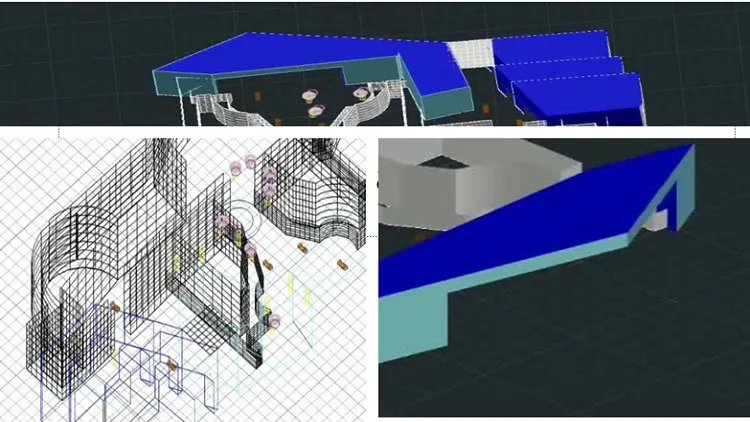
AutoCAD Text Settings AutoCAD Text Style AutoCAD Mtext Editor Single Line Text Font Size 
This course provides an introduction to AutoCAD Text Settings, AutoCAD Text Style, AutoCAD Mtext Editor, Single Line Text, and Font Size. It covers topics such as creating new Text Style, editing Single Line Text, changing font or text style, adding symbols, changing case, inserting fields, and more. It also covers Multi Line Text (Mtext Command), including Subscript/Superscript, Change Case, Oblique Angle, Width Factor, Bullets and Numbering, Line Spacing, Insert Symbol, Find & Replace, Show/Hide Rule, and Edit MText. ▼
ADVERTISEMENT
Course Feature
![]() Cost:
Cost:
Free
![]() Provider:
Provider:
Youtube
![]() Certificate:
Certificate:
Paid Certification
![]() Language:
Language:
English
![]() Start Date:
Start Date:
On-Demand
Course Overview
❗The content presented here is sourced directly from Youtube platform. For comprehensive course details, including enrollment information, simply click on the 'Go to class' link on our website.
Updated in [February 21st, 2023]
This course provides an overview of AutoCAD Text Settings, AutoCAD Text Style, AutoCAD Mtext Editor, and Single Line Text Font Size. Participants will learn how to create new Text Style, create Single Line Text, edit Single Line Text, change Text Justification, change Text Height, change Text Width Factor, change Single Line Text Font or Text Style, add symbol to Single Line Text, underline Single Line Text, change Case of Single Line Text, insert Field in Single Line Text, Multi Line Text (Mtext Command), change Case, Oblique Angle, Width Factor, Bullets and numbering, Line Spacing, Insert Symbol, Find & Replace, Show/Hide Rul, and Edit MText.
[Applications]
After this course, participants can apply the knowledge they have gained to create and edit text in AutoCAD. They can create new text styles, create single line text, edit single line text, change text justification, change text height, change text width factor, change single line text font or text style, match properties of text, add symbols to single line text, insert fields in single line text, create multi-line text, change case of multi-line text, insert symbols in multi-line text, find and replace text, show and hide rulers, and edit multi-line text.
[Career Paths]
1. CAD Technician: CAD Technicians use AutoCAD to create technical drawings and plans for a variety of projects. They are responsible for creating detailed drawings of buildings, machines, and other structures, as well as ensuring accuracy and quality control. The demand for CAD Technicians is increasing as more companies are relying on computer-aided design to create their products.
2. CAD Designer: CAD Designers use AutoCAD to create 3D models and drawings for a variety of projects. They are responsible for creating detailed designs of buildings, machines, and other structures, as well as ensuring accuracy and quality control. The demand for CAD Designers is increasing as more companies are relying on computer-aided design to create their products.
3. CAD Manager: CAD Managers are responsible for managing the CAD team and ensuring that all projects are completed on time and within budget. They are also responsible for training and developing new CAD personnel, as well as ensuring that all CAD software is up to date and functioning properly. The demand for CAD Managers is increasing as more companies are relying on computer-aided design to create their products.
4. CAD Developer: CAD Developers are responsible for developing and maintaining CAD software. They are responsible for creating new features and tools for CAD software, as well as ensuring that all CAD software is up to date and functioning properly. The demand for CAD Developers is increasing as more companies are relying on computer-aided design to create their products.
[Education Paths]
1. Bachelor of Science in Computer Aided Design (CAD): This degree program focuses on the use of computer-aided design (CAD) software to create technical drawings and designs. Students learn how to use CAD software to create 3D models, create technical drawings, and develop design plans. They also learn about the principles of engineering, mathematics, and physics that are used in CAD. This degree is becoming increasingly popular as more businesses and industries rely on CAD software for their design needs.
2. Bachelor of Science in Computer Science: This degree program focuses on the fundamentals of computer science, including programming, software engineering, and computer architecture. Students learn how to design, develop, and maintain computer systems and software. They also learn about the principles of mathematics, engineering, and physics that are used in computer science. This degree is becoming increasingly popular as more businesses and industries rely on computer systems and software for their operations.
3. Bachelor of Science in Information Technology: This degree program focuses on the use of information technology to solve business problems. Students learn how to design, develop, and maintain computer systems and software. They also learn about the principles of mathematics, engineering, and physics that are used in information technology. This degree is becoming increasingly popular as more businesses and industries rely on information technology for their operations.
4. Bachelor of Science in Robotics: This degree program focuses on the use of robotics to solve problems. Students learn how to design, develop, and maintain robotic systems. They also learn about the principles of mathematics, engineering, and physics that are used in robotics. This degree is becoming increasingly popular as more businesses and industries rely on robotics for their operations.
Course Provider

Provider Youtube's Stats at AZClass
Discussion and Reviews
0.0 (Based on 0 reviews)
Explore Similar Online Courses

How to Edit Videos with Filmora 11 - Beginners Class

Learning MongoDB - NoSQL database

Python for Informatics: Exploring Information

Social Network Analysis

Introduction to Systematic Review and Meta-Analysis

The Analytics Edge

DCO042 - Python For Informatics

Causal Diagrams: Draw Your Assumptions Before Your Conclusions

Whole genome sequencing of bacterial genomes - tools and applications

Learn Autocad basics from projects

AutoCAD Basic Commands for Beginners with practical Approach


Start your review of AutoCAD Text Settings AutoCAD Text Style AutoCAD Mtext Editor Single Line Text Font Size